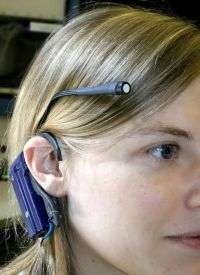New approach sheds light on ways Circadian disruption affects human health

Growing evidence indicates that exposure to irregular patterns of light and darkness can cause the human circadian system to fall out of synchrony with the 24-hour solar day, negatively affecting human health — but scientists have been unable to effectively study the relationship between circadian disruptions and human maladies.
A study by researchers in Rensselaer Polytechnic Institute's Lighting Research Center (LRC) provides a new framework for studying the effects of circadian disruption on breast cancer, obesity, sleep disorders, and other health problems.
Light and dark patterns are the major synchronizer of circadian rhythms — the biological cycles that repeat approximately every 24 hours — to the solar day. Inadequate or irregular light exposure can cause circadian rhythm disruptions that are believed to manifest into a variety of health ailments. However, ecological studies to measure human light exposure are virtually nonexistent, making it difficult to determine if, in fact, light-induced circadian disruption directly affects human health.
LRC researchers have created a small, head-mounted device to measure an individual's daily rest and activity patterns, as well as exposure to circadian light — short-wavelength light, particularly natural light from the blue sky, that stimulates the circadian system. The device, called the Daysimeter, was sent to 43 female nurses across the country to measure their daily exposure to circadian light, according to Mark Rea, director of the LRC and principal investigator on the project.
The Daysimeter was worn for seven days by both day-shift and rotating shift nurses and then returned to the LRC for analysis. Simultaneously, Rea and his colleagues studied the effect of irregular light exposure to the circadian system of 40 rats, in order to determine if the relationship between circadian disruption and health outcomes could be uncovered using rodent models.
Twenty rats were exposed to a consistently repeating pattern of 12 hours of light followed by 12 hours of dark, to mimic the light exposure experienced by day-shift workers. The remaining rodents were exposed to irregular 12-hour patterns of light and darkness.
For the nurses, circadian entrainment and disruption was measured by comparing exposure light and darkness with each individual's rest and activity patterns. Wheel running was used to measure rat rest and activity patterns.
A quantitative measure of circadian behavioral entrainment or disruption for day-shift and rotating shift workers was developed based on the circular cross-correlations of activity and light exposure data from both the nurses and the rats. An analysis technique commonly utilized in the field of signal processing, circular
cross-correlation involves the concept of time-shifting one signal relative to another to determine relationships between signals that might otherwise be obscured due to timing differences.
"We found that the circadian entrainment and disruption patterns for day-shift and rotating shift nurses were remarkably different from each other, but remarkably similar to the patterns for the two parallel groups of nocturnal rodents," says Rea. "The marked differences within species, together with the marked similarities across species, in addition to the new method of quantifying circadian entrainment or disruption suggests that health-related problems associated with circadian disruption in humans can be parametrically studied using animal models."
"This ability to quantitatively define circadian light and dark for humans and for animals will allow a new class of meaningful studies of light as a stimulus for circadian entrainment or disruption to be undertaken, not only in humans, but in nocturnal rodents as well – which, until now, has been impossible," says Rea. "Additionally, studies of circadian disruption employing animal models for human disease can now be designed and conducted to more accurately reflect their relevance to the actual living conditions in humans."
The study is published online in the Journal of Circadian Rhythms and can be viewed in its entirety at: www.jcircadianrhythms.com/content/6/1/7 .
Source: Rensselaer Polytechnic Institute



















